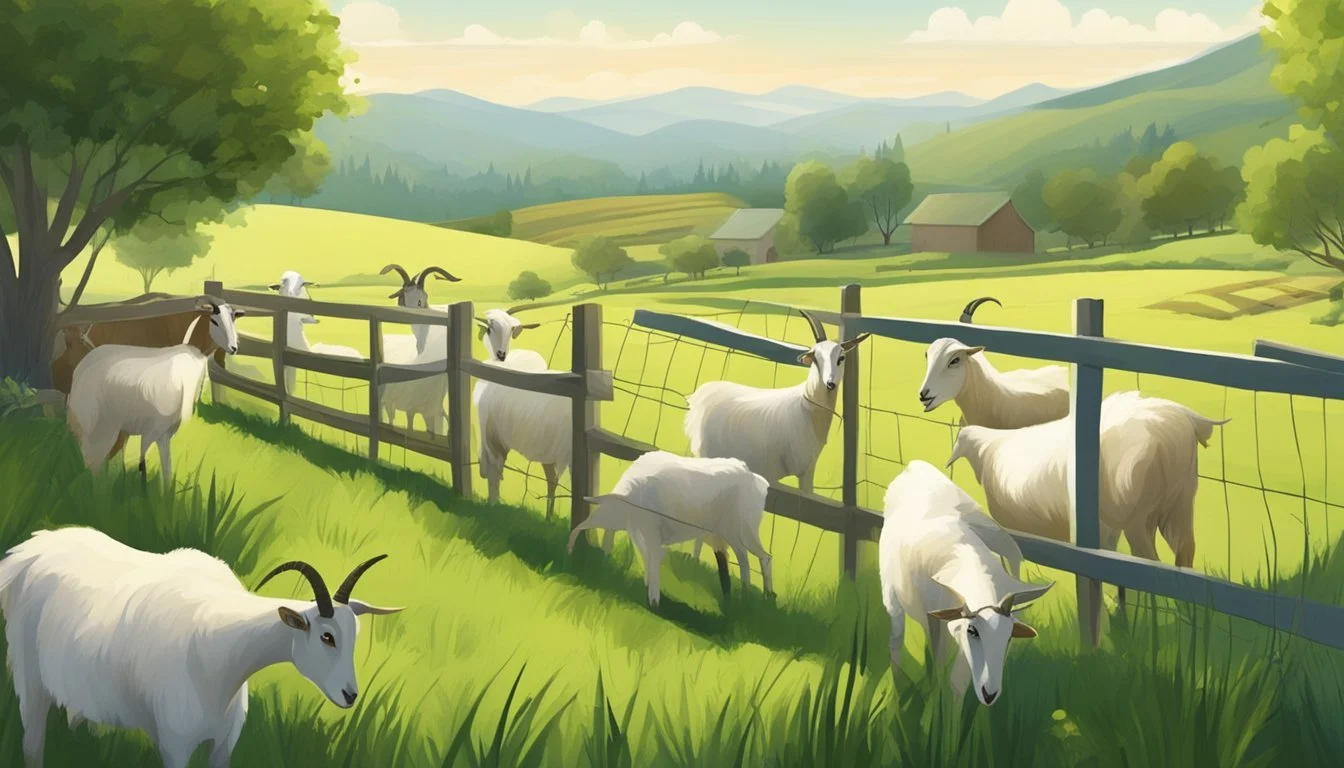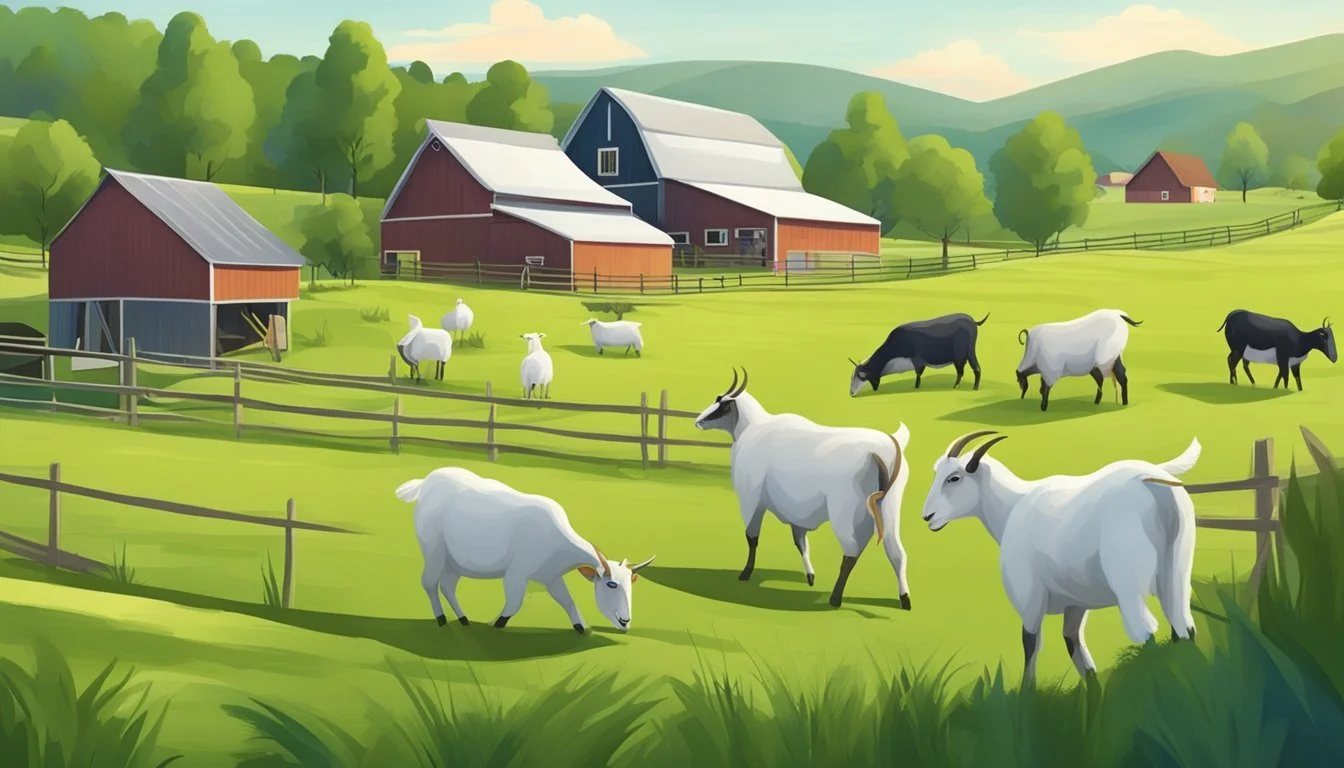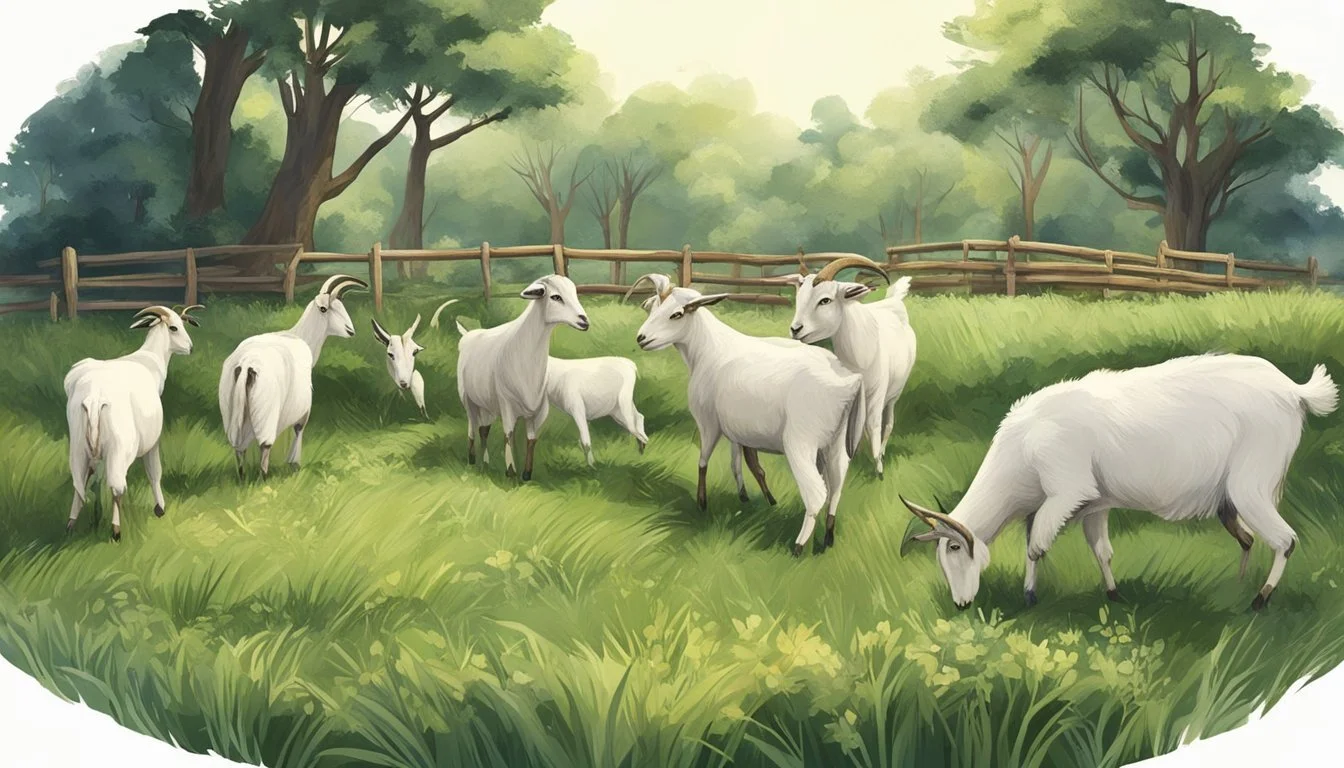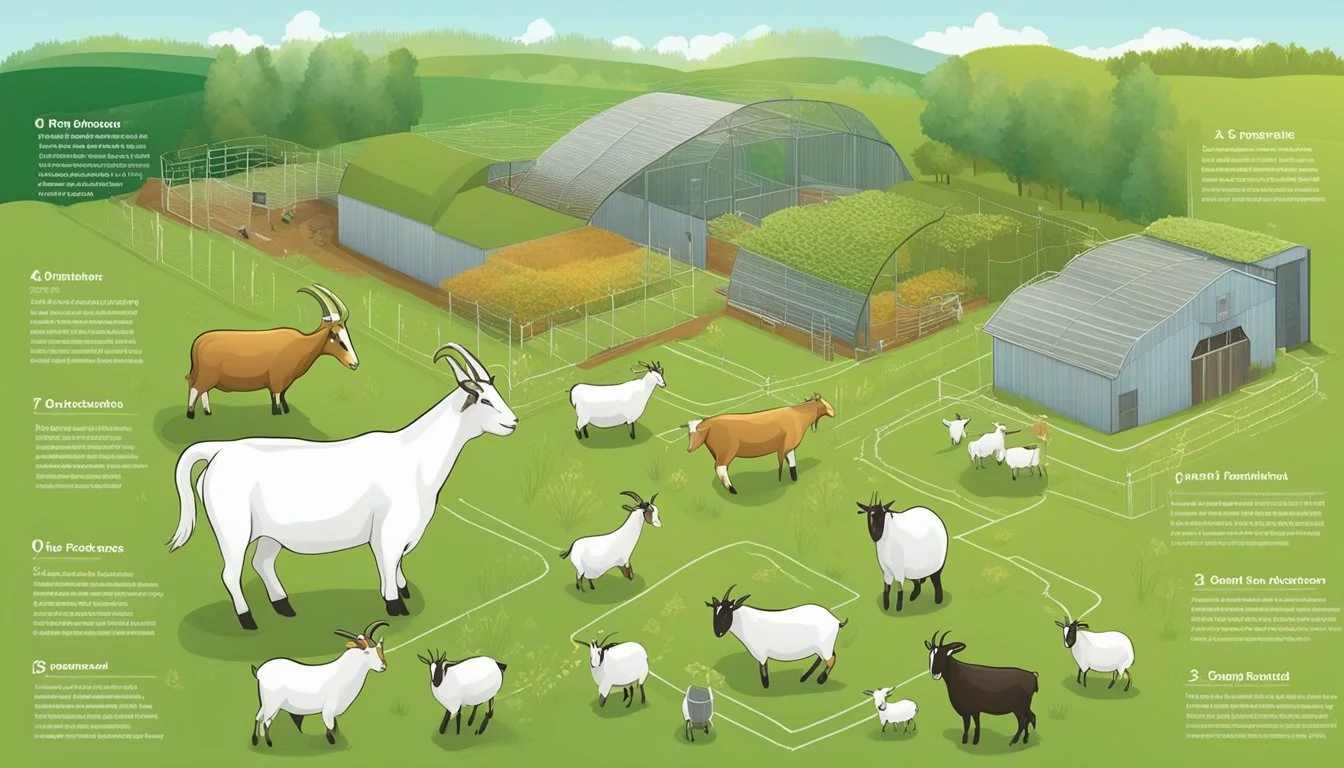What Are the Rules for Organic Goat Farming?
Essential Guidelines for Ethical Practices
Organic goat farming adheres to strict guidelines designed to promote sustainable agriculture and animal welfare. In organic production, farmers must provide goats with access to the outdoors, fresh air, clean drinking water, direct sunlight, and certified organic feed. Goats should graze on pasture that is managed without the use of synthetic pesticides or herbicides, in line with the organic livestock requirements set by the USDA. The well-being of the animals is paramount, with organic practices seeking to minimize stress and health issues among the herd.
Organic certification also requires adherence to specific rules concerning the prohibition of synthetic substances and allows only natural substances in organic farming, as detailed in the National List of Allowed and Prohibited Substances. Additionally, organic goat farmers must implement practices that support ecological balance and conserve biodiversity, often involving rotational grazing and sustainable pasture management. These standards ensure that the production process is not only healthy and safe for the animals but also for the consumers who ultimately benefit from the high-quality organic goat products.
Overview of Organic Goat Farming
Organic goat farming is a method that aligns with the ethos of sustainability, environmental stewardship, and responsible livestock management by adhering to the strict guidelines of organic production. This approach emphasizes the health of the animals, the land they graze upon, and the overall integrity of the farming ecosystem.
History and Development of Organic Goat Farming
The concept of organic farming has its roots in the early 20th century, a time when agriculturalists began to seek alternatives to the growing reliance on synthetic chemicals. Organic goat farming emerged as part of this broader organic agriculture movement, focusing on the importance of natural practices and the well-being of goats. It grew from a niche practice among smallholders into a significant sector within the organic community, gaining momentum as consumers became more aware of animal welfare and environmental issues.
Principles of Organic Livestock Farming
Organic livestock farming, including that of goats, operates on several foundational principles. First, it mandates the use of certified organic feed that is free from synthetic pesticides, herbicides, and GMOs. Second, it stresses the importance of sustainable practices such as rotational grazing, which not only preserves pasture land but also enhances soil fertility and biodiversity. Furthermore, organic livestock farming requires the humane treatment of animals, prohibiting the use of hormones and unnecessary antibiotics, thereby fostering an environment for the livestock to thrive naturally.
Benefits of Organic Goat Farming
Organic goat farming offers several benefits. It produces high-quality goat products that are free from synthetic residues, appealing to consumers interested in health and food safety. Additionally, this approach supports environmental stewardship by minimizing the farming operation's carbon footprint and promoting biodiversity. Organic farmers also benefit from a growing market seeking organic goods and potentially from premiums associated with organic products. With its dual focus on sustainability and profitable farming systems, organic goat farming presents a forward-looking approach to agriculture.
Understanding Organic Regulations and Certification
The crux of organic goat farming lies in the rigorous adherence to USDA organic regulations, guided by the National Organic Program (NOP). Producers must navigate through a meticulous certification process and comply with specified allowable substances, all while participating in a transparent system that values public input during rulemaking.
The USDA National Organic Program
The NOP is a regulatory program housed within the USDA’s Agricultural Marketing Service. This program is responsible for creating national organic standards and ensuring uniform compliance. Under the NOP, organic farms must foster practices that promote ecological balance, conserve biodiversity, and utilize resources such as crop rotations, cover crops, and managed manure.
Certification Process for Organic Farms
To become a certified organic farm, operations must first submit an application to a USDA-accredited certifying agent. This application details the operation’s processes conforming to organic regulations. Following submission, an inspector reviews the farm in person to ensure compliance with NOP standards. Successful certification grants the operation the right to use the term "organic" and the USDA organic seal on their products.
National List of Allowed and Prohibited Substances
Maintaining organic integrity involves adhering to the National List of Allowed and Prohibited Substances which stipulates what inputs may be used in the organic farming process. Items on this list include fertilizers, pesticides, and other substances critical in organic goat farming. These are carefully vetted to align with the program's organic principles.
Public Comments and Rulemaking Process
The NOP’s rulemaking process involves gathering feedback through public comments. This step is vital for maintaining transparency and allowing stakeholders to contribute to the formation and revision of organic policies. The National Organic Standards Board, an advisory committee, plays a key role in reviewing changes and guiding the incorporation of public feedback into USDA organic regulations.
Organic Farm Management Practices
Organic goat farming requires a detailed approach to management, focusing on natural practices and well-being of the animals. These practices are designed to enhance the health of the goats, ensure high-quality milk and meat production, and maintain the integrity of the organic label.
Pasture Management and Rotational Grazing
Goats must have access to pasture made up of a variety of plant species. Rotational grazing is a critical component of pasture management, where goats are moved to fresh paddocks to allow vegetation to recover, prevent soil erosion, and reduce the buildup of parasites. This method not only sustains the pasture's health but also ensures the goats receive nutritious forage, which can reduce the reliance on external feed inputs.
Feed and Nutrition
Goats require a diet that meets their nutritional needs with organic feed, free from synthetic additives, GMOs, and animal by-products. A balanced ration includes a diversity of organic hay, grains, and minerals to maintain their health and productivity. The organic standards dictate that all feed must be certified organic, ensuring that feed and nutrition processes remain natural and sustainable.
Health Management and Veterinary Care
Organic farming emphasizes disease prevention through good husbandry practices. When intervention is necessary, preference is given to natural and alternative treatments. The use of antibiotics is strictly regulated; they can only be used when an animal's health is at risk, and any treated animal's products cannot be sold as organic. Deworming strategies rely on rotational grazing and botanical remedies instead of chemical dewormers. Vitamin E and other natural supplements can be vital in health management to enhance their immune system.
Reproduction and Breeding
The fertility of goats in an organic setup is managed naturally without the use of hormones. Breeding programs focus on selecting traits that enhance the animal's adaptation to organic production systems, including resistance to parasites and diseases. Reproduction and breeding practices must align with organic principles, ensuring the welfare of the animals is of utmost importance.
Animal Husbandry and Welfare
Proper animal husbandry and welfare are fundamental to organic goat farming. Adherence to rigorous standards ensures that animals live in environments that meet their physiological and behavioral needs, with a strong emphasis on humane treatment during handling and transport. These standards also restrict unnecessary physical alterations to promote the goats' overall wellbeing.
Shelter and Housing Requirements
Organic goat farming stipulates that shelter and housing should provide adequate space, comfort, and protection to maintain the health and welfare of the goats. It is required that each animal must have access to a well-ventilated, clean, and dry resting area. Bedding must be natural and absorbent to promote comfort and reduce moisture. The housing must also allow for the animals' natural behavior and well-being, which includes provisions for exercise areas and sufficient space for all goats to move freely.
Space requirements: Adequate space is necessary for the health and well-being of the goats, preventing overcrowding and allowing natural behaviors.
Bedding: Must be comfortable, absorbent, and regularly maintained to ensure cleanliness.
Ventilation: Housing must be well-ventilated to prevent the build-up of dampness and gases, all of which can adversely affect goat health.
Handling and Transport
The handling of goats should minimize stress and avoid injury. Handlers are expected to be trained and competent in goat behavior and handling techniques. When transport is necessary, it must occur in a way that secures the animals against injury and minimizes distress. Vehicles used for transportation should be designed to meet the goats' needs, including adequate space, ventilation, and access to water for longer journeys.
Handling: Must be performed by trained individuals who use techniques that prevent distress and injury to the animals.
Transport: Vehicles and practices should prioritize animal welfare, with efforts made to minimize the duration and stress of travel.
Physical Alterations Prohibitions
Organic goat farming sets strict guidelines against physical alterations which are not necessary for their well-being or safety. Practices such as dehorning or disbudding are typically discouraged unless essential for the safety of the animal or its herd mates. When physical alterations are deemed necessary, they must be carried out in a manner that minimizes pain and stress, often necessitating the use of approved anesthetics and analgesics.
Physical Alterations: Strongly regulated, with a focus on prohibiting unnecessary procedures and ensuring that any necessary alterations are performed as humanely as possible.
Environmental Impact and Conservation
Organic goat farming is intricately linked to environmental preservation, emphasizing the importance of soil and water conservation, the maintenance of biodiversity and ecological balance, and the implementation of sustainable agricultural practices. These approaches underscore the commitment to environmental stewardship and sustainability.
Soil and Water Preservation
Organic goat farming places a premium on the health of the soil and water systems. These farms typically employ methods such as moderate grazing, which has been noted to prevent soil erosion and maintain water quality. The practice of moderate grazing can encourage the growth of diverse plant species, leading to a more robust and sustainable ecosystem.
Biodiversity and Ecological Balance
Maintaining ecological balance is a cornerstone of organic farming. Organic goat farms contribute to biodiversity by preserving wildlife habitats and corridors. Through targeted browsing habits, goats can control the spread of noxious weeds, which helps maintain and improve local vegetation diversity, advancing the farm's contribution to conservation and ecosystem health.
Agricultural Practices and Residue Management
The focus on sustainable practice within organic goat farming encompasses agricultural residue management. The organic waste generated by goats can be managed effectively, converted into compost, and utilized to enrich the soil, contributing to a cycle of sustainability and promoting healthier crop production. This closed-loop system underscores the broader commitment to environmental stewardship, often leading to reduced reliance on artificial inputs and minimizing ecological footprints.
Organic Goat Products
Organic goat farming encompasses the production of various products including dairy, meat, and fiber, all adhering to stringent organic standards. The focus on natural processes and welfare ensures that these products are not only ethically produced but also maintain their organic integrity from farm to consumer.
Milk and Dairy Production
Organic dairy goats produce milk that must come from animals raised on certified organic pastures and fed organic feed, without the use of prohibited substances such as pesticides, synthetic hormones, or antibiotics. Certification ensures the organic goat milk is produced following these strict guidelines. The organic milk production process also monitors for proper animal health and welfare, ensuring that the dairy goats are well-cared for.
Meat and Fiber Production
Organic standards for goat meat and fiber focus similarly on the animal's diet and living conditions. Organic meat production involves raising goats without synthetic growth hormones and ensuring that any supplements provided follow organic regulations. Fiber production from goats, such as cashmere or mohair, adheres to the same animal welfare and organic feed standards to ensure the end products can be certified organic.
Processing and Handling of Organic Products
Once organic products like goat milk or cheese leave the farm, strict procedures are in place for their processing and handling. The aim is to preserve the organic integrity and prevent contamination with non-organic substances. Regulation from agencies such as the USDA guides these processes and handling, specifying the allowed and prohibited substances for organic certification. Organic cheeses and other goat-derived foods must be processed in certified facilities to retain their organic label.
Feeds and Feeding
In organic goat farming, it's crucial to use feeds that adhere to strict organic standards. Feed choices have direct implications on the health of goats and the quality of products such as milk and meat.
Types of Organic Feed
Organic goat feeds comprise a variety of substances such as forages, grains, and organic pellets. High-quality hay forms the backbone of most diets, providing necessary stems and leaves to fulfill a goat's grazing needs. The grains often include corn, oats, and sorghum, which must be certified organic, ensuring they are free from synthetic agents. As goats require a mixed diet, rye and other organic foods are also integrated into feed regimens.
Nutritional Requirements
Goats need a balanced diet to thrive, which includes adequate amounts of carbohydrates, proteins, fats, minerals, and vitamins. Organic feed must meet these nutritional demands while aligning with organic farming principles. For protein, pellets typically consist of a mix of organic plant sources, and for energy, organic grains are key contributors. Adequate amounts of fiber are obtained from organic hay, which assists in digestive health.
Supplements and Additives
While organic standards limit the use of synthetic additives, certain supplements are permissible to ensure goats receive all the necessary nutrients. This might include supplements for minerals like selenium or copper, which are vital for goats' health. Additionally, for improved omega-3 fatty acid intake, certain organic formulations might be enhanced with natural sources like flaxseed. Supplements and additives should always be certified organic and used in moderation within the dietary plan.
Common Challenges and Solutions
In organic goat farming, it's essential to address hurdles spanning from health to economic viability while adhering to organic standards. Effective strategies are crucial to ensure the welfare of goats and the sustainability of the farm.
Managing Internal and External Parasites
Internal parasites, such as worms, can undermine the health and productivity of goats, necessitating careful management. Regular fecal checks and rotational grazing are effective strategies. Instead of using conventional dewormers, organic farmers prioritize natural remedies and preventative practices. External parasites, like lice and mites, are managed through meticulous grooming and by maintaining clean living conditions.
Preventative Measures:
Fecal egg count monitoring
Rotational grazing to break parasite life cycles
Herbal dewormers
Diatomaceous earth for external parasites
Coping with Environmental Stresses
Goats raised in arid or semi-arid regions need strategies to combat heat stress and ensure adequate ventilation in their living quarters. Organic goat farming requires shelter designs that facilitate airflow and protection from severe weather. Access to shade and clean water is fundamental.
Shelter Considerations:
Orientation to maximize cross-ventilation
Insulation to mitigate temperature extremes
Market and Economic Considerations
Organic goat products command a niche market, but economic sustainability can pose a challenge. Farmers must balance costs, such as those for organic feed and husbandry practices devoid of growth hormones and synthetic inputs. Diversification in products, direct marketing, and adoption of a semi-intensive system of management can enhance economic resilience.
Economic Strategies:
Direct sales to consumers
Diversified product range (cheese, milk, meat, fiber)
By focusing on these targeted areas, organic goat farmers can overcome common challenges and pave the way for a thriving organic agriculture system.
Organic Farming in Different Regions
The adaptability of organic goat farming demands tailoring practices to the regional climate and resources, ensuring clean pasture and adhering to organic agriculture standards.
Organic Goat Farming in Arid and Semi-arid Areas
In arid and semi-arid regions such as parts of India, organic goat farmers focus on water conservation and pasture management to maintain a clean and sustainable environment for their herds. They often implement dryland farming techniques that capitalize on limited water resources. For example, the use of drip irrigation systems can supply water directly to crop roots, decreasing evaporation and conserving water. Additionally, farmers may employ mulching to retain soil moisture and reduce water needs.
Strategic feed management is crucial as well. Goats are naturally adept at thriving in harsh conditions, making them suitable for arid climates where water and lush pastures are scarce. Farmers provide their goats with feed that meets organic standards, omitting synthetic inputs and emphasizing natural growth.
Organic Goat Farming in Varied Climates
Organic goat farming in regions with varied climates, where weather conditions fluctuate, requires a dynamic approach to pasture management. Farmers must assess the geographic climate's impact on grazing season length and pasture quality. The goal is to maximize access to certified organic pasture throughout the entire grazing season, adjusting for regional differences.
Farmers in these climates also practice rotational grazing to prevent overgrazing and to maintain soil health. By moving the goats to fresh patches of pasture land regularly, they ensure that the land has adequate time to recover, supporting the overall ecosystem's integrity.
In both arid and varied climates, understanding the specific needs of organic goat farming based on regional characteristics is essential. Practices such as careful resource management in arid areas and adaptable grazing strategies in varied climates are key elements that enable organic goat farming to be successful across diverse regions.








